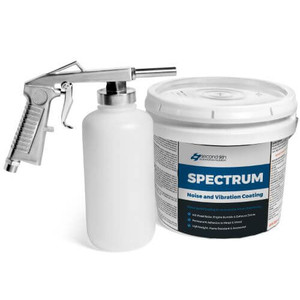Quality Sound Deadening Material Makes a Difference
Don't Be Fooled.
The best products combine a butyl rubber, elastomeric compound with a thick,
high-quality foil. They also don't use "filler" material, that's cheap but
hurts performance. Think about it this way. Using filler is like stuffing your meatballs
full of rice to make them bigger. Sure, you've got bigger meatballs. But they don't taste as good,
because there's a lot of rice in there and it's not as FLAVORFUL. More filler makes the mat less
rubbery and less elastomeric, so it won't snap back into shape like it's supposed to.
When we manufacture our Damplifier™ and Damplifier Pro™
self-adhesive sheets, we cut out all the fillers. Who wants a product that looks thick
if it performs worse? Not us. We also don't use cheap, flimsy foil. Yes... that would save us money,
but it won't constrain the butyl adhesive as well to stop those vibrations. Again, you've got an inferior
product.
That attention to detail is why our product specs are so much better than competing products.
The worst quality sound deadening material you can buy is made from asphalt roofing
material. (No... just no.) Yes, asphalt will deaden metal a little bit so you'll see SOME impact.
Somewhere between 10% and 30% the effectiveness of Damplifier Pro™. And maybe that sounds ok to
you, because
you're willing to sacrifice performance to save some money. The reason we avoid asphalt entirely in
automotive is because
we don't mess around with the health concerns. We are especially concerned about using
cheap sound deadening materials around heat producing
components or
in a warmer climate, because asphalt will melt and out gas chemicals at high temperatures.
Avoid the sticky mess and the fumes. Keep asphalt on your roof or on the road, not inside
your car.
How do I know if a sound deadener has asphalt? None of them mention asphalt anywhere!
(Wonder why that is…) That's the hardest thing about automotive sound deadening for your average DIY
researcher.
It can be hard to tell what's INSIDE the various mats. If you've read down to here in an article about
automotive sound deadening, you care about improving the sound quality of your ride. Fortunately, there are
some easy tells you can look for:
-
Anything sold by the roll is likely to be repurposed roofing material like what you can get
at the local hardware store. It
probably contains asphalt, and it definitely doesn't have a solid foil constraint layer. You can't
roll up good foil like that.
-
Look for the temperature rating. Asphalt melts at a lower temperature than rubber, so as you
start seeing a lower
temperature range – the sound deadening material has cheaper fillers in it at best, but
probably contains asphalt.
-
Buy made in the USA. While we've found USA-made products with a high filler content, we have
yet to see one with an asphalt base.
The imported sound deadening mats tend to be much cheaper per sqft, and much more likely to use
asphalt.
So there you go – one of the sound deadening industry's dirty little secrets. Use
the information how you will.
Damplifier Pro™ and Damplifier™ have been the sound deadener of choice for car audio
enthusiasts for over 20 years. When you upgrade a stereo system, the sound energy
being put out is upgraded beyond what the car’s original engineers intended. Unless
you want vibrating metal to be part of the background noise, you can’t skip the deadener
and you can’t use cheap “placebo effect” deadeners that you hope will solve the problem.
Don’t take it from us though. Just ask Steve Meade, EXOcontralto, or your neighbor Carl
about how they all use Second Skin for their car audio builds. That fancy new stereo system
is just begging you to fix the stereo sound with some Damplifier Pro. Try it out, and future you
will be grateful.
And if you're looking for an alternate sound deadening product
to our mats, try a
sound deadening
spray like Spectrum™ or the thicker Spectrum Sludge™.
Both are water-based viscoelastic materials specifically formulated by Second Skin for
high performance and easy workability. Yes, they work well. They're also easy to clean
up with soap and water, environmentally friendly, and non-toxic. You just apply them
differently. Spectrum™ is easy to spray, brush, or roll on. You
can use it in place of our Damplifier products or in addition to them,
because they can go places where it's hard to apply a
sound deadening mat, like your vehicle's undercarriage or for
wheel well soundproofing.












